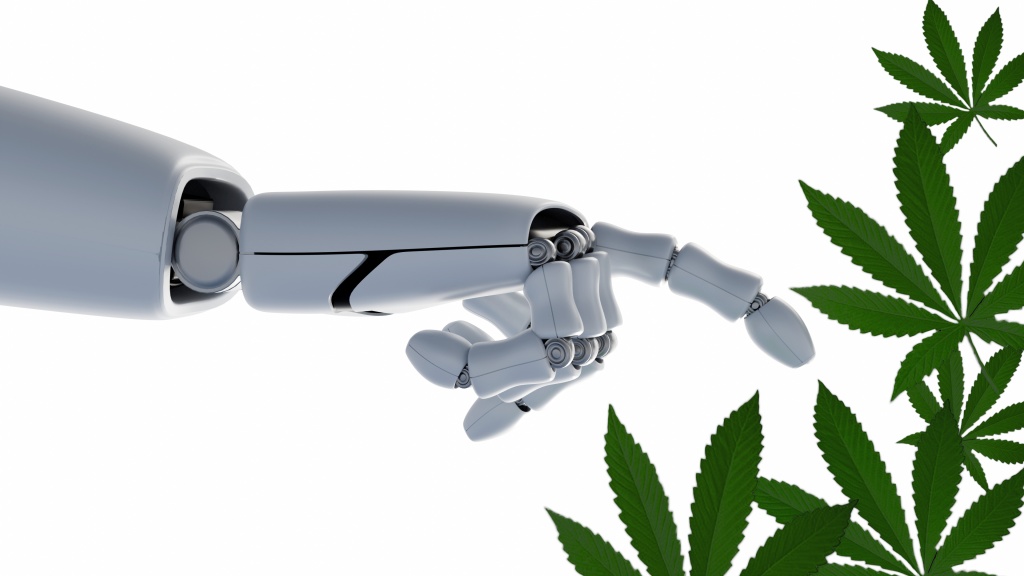AI in cannabis: 5 ways to level up your weed business

We’ve reached a point where artificial intelligence—widely known as AI—is an inescapable part of our culture. Generative AI models, such as ChatGPT, have entered classrooms and workplaces. The healthcare industry is experimenting with their use to detect diseases like cancer and Alzheimer’s, and the government is poised to utilize them in warfare. Whether you love it or hate it, AI is a part of our world now, and it seems like it’s here to stay. With the skyrocketing interest in the technology, many have begun to wonder if it can be leveraged in the cannabis space.
Turns out it already has been to some degree: cultivators and retailers alike have found gaps in their processes that can be made faster with automation, and many have begun to patch them up. Cannabis quality is of utmost importance—especially in the strange political landscape in which we live, where stories of unsafe weed can spur prohibition efforts. Turns out AI has the potential to prioritize safety and speed all at once, unlike most humans.
RELATED: What most people get wrong about the cannabis industry
This new layer of the marijuana industry may still be a blind spot for many, especially those who’ve been here for a while. If you need a quick crash course, here’s a list of five ways you can use AI to improve your cannabis business:
Safe Cannabis Production
As previously mentioned, growing safe, high-quality cannabis is a hard process that requires a great deal of energy and manual labor. To test the health of flower, workers previously had to spend a significant amount of time with each plant, attempting to detect any signs of stress or other defects. Even then, the results could never be 100 percent accurate due to unavoidable human errors.
AI products from companies like Netleaf and Grownetics, on the other hand, have been deployed in a number of large growing facilities and have made noticeable progress. Automatic sensors use video analytics and other machine learning techniques to track data like humidity and leaf color and make charts with their findings, providing growers with the information they need to optimize their yield. Not only does this allow weed to be made safely, but also for it to be made at a higher rate. When you rush humans, you get worse results—the same can’t be said for AI.
AI is also able to detect possible pest and disease outbreaks early, giving time to prevent them, as well as analyze genetic data to make the most enjoyable product.
Harvesting
Harvesting cannabis is a very delicate process. If the plant is gathered too early or too late, it can lose potency or not survive, rendering growing efforts useless. AI-powered robots have been used to automate this process, giving the flower the best chance of success.
Robots have been developed by companies like Bloom Automation to identify ripe flowers and carefully trim buds from branches, preserving safety and ensuring that growing facilities aren’t wasting their time by missing the desired harvesting window. This also reduces reliance on manual labor and long hours spent closely monitoring flowers.
Post-Harvest Phase
As much as we’re taught not to judge books by their covers, humans can’t help but make decisions based on presentation. Weed can be of the highest quality, but if it doesn’t have “bag appeal” (achieved by trimming, weighing, and more), it can be a hard sell. Assembly lines have traditionally been the avenue through which newly-grown flower has become ready to be bagged and shipped to dispensaries, but AI has begun to do the same quicker and more accurately.
“Standardization is one of the cornerstones of building relationships,” said Wes Winton, director of marketing at a company called GreenBroz that makes automated processing equipment.
Using AI in this process also gives manufacturers a clearer understanding of the usable yield they can expect, allowing them to plan for the future in terms of the additional resources required for further growth and methods to improve low yields.
Market Predictions
Like any other industry, cannabis companies must be knowledgeable about the latest market trends to ensure they are creating an appropriate amount of product to meet shifting demand. Accurately tracking these things for non-experts is tedious at best, impossible at worst, but groups like Canna Spy Glass offer business owners updated market data based on consumption patterns and other market data.
AI is able to optimize supply chains by predicting demand, handling logistics, and providing insight into what inventory should look like—in doing so, the cannabis industry can waste less quality weed and sell more of it by matching what people want most.
Customer Service
Many companies have been using AI chatbots to replace customer service personnel for a while now, and cannabis retailers are no exception. AI budtenders like Spark and Zippy (created by Jointly and Terpli, respectively) are able to track consumers’ weed usage and use it, combined with a large database of weed and its properties, to recommend strains and products best for the mood you desire.
These tools make the lives of many retailers much easier, as they give the general population knowledge that was once very inaccessible. Instead of having to answer a million questions to give a customer the perfect product for them, these chatbots can streamline the process, giving sellers more time to market and actually sell more weed.
RELATED: This guide will transform your cannabis company’s marketing strategy
AI is cannabis’s future
The weed and AI industries are two that dominate much of the mainstream political narrative as of late, and this trend is likely to continue as they combine forces. Cannabis professionals have no time or resources to waste at such a pivotal time in the industry, and AI might be the thing that will ensure that they stay afloat.